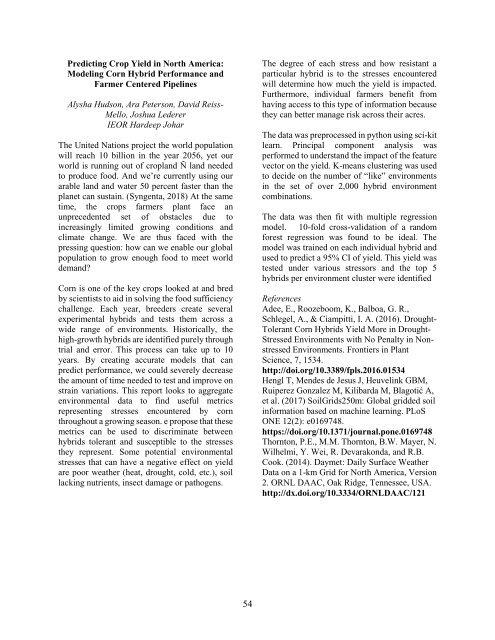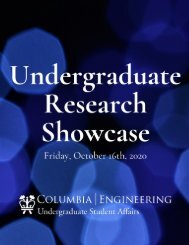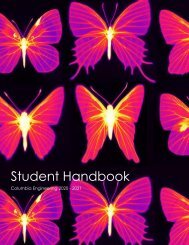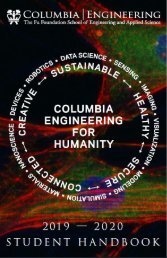Senior Design Expo 2019
The Senior Design Expo, held annually in May at Columbia University, is an opportunity for Columbia Engineering students to showcase what they have learned in their foundational math and science courses together with their engineering courses in innovative, creative, and purposeful designs and prototypes. Each year the Expo showcases more than 60 projects across all nine departments. Projects have included cutting-edge robotics, the New York City subway system, language technology, proposals for bridges to span the Hudson river, and much more.
The Senior Design Expo, held annually in May at Columbia University, is an opportunity for Columbia Engineering students to showcase what they have learned in their foundational math and science courses together with their engineering courses in innovative, creative, and purposeful designs and prototypes. Each year the Expo showcases more than 60 projects across all nine departments. Projects have included cutting-edge robotics, the New York City subway system, language technology, proposals for bridges to span the Hudson river, and much more.
Create successful ePaper yourself
Turn your PDF publications into a flip-book with our unique Google optimized e-Paper software.
Predicting Crop Yield in North America:<br />
Modeling Corn Hybrid Performance and<br />
Farmer Centered Pipelines<br />
Alysha Hudson, Ara Peterson, David Reiss-<br />
Mello, Joshua Lederer<br />
IEOR Hardeep Johar<br />
The United Nations project the world population<br />
will reach 10 billion in the year 2056, yet our<br />
world is running out of cropland Ñ land needed<br />
to produce food. And we’re currently using our<br />
arable land and water 50 percent faster than the<br />
planet can sustain. (Syngenta, 2018) At the same<br />
time, the crops farmers plant face an<br />
unprecedented set of obstacles due to<br />
increasingly limited growing conditions and<br />
climate change. We are thus faced with the<br />
pressing question: how can we enable our global<br />
population to grow enough food to meet world<br />
demand?<br />
Corn is one of the key crops looked at and bred<br />
by scientists to aid in solving the food sufficiency<br />
challenge. Each year, breeders create several<br />
experimental hybrids and tests them across a<br />
wide range of environments. Historically, the<br />
high-growth hybrids are identified purely through<br />
trial and error. This process can take up to 10<br />
years. By creating accurate models that can<br />
predict performance, we could severely decrease<br />
the amount of time needed to test and improve on<br />
strain variations. This report looks to aggregate<br />
environmental data to find useful metrics<br />
representing stresses encountered by corn<br />
throughout a growing season. e propose that these<br />
metrics can be used to discriminate between<br />
hybrids tolerant and susceptible to the stresses<br />
they represent. Some potential environmental<br />
stresses that can have a negative effect on yield<br />
are poor weather (heat, drought, cold, etc.), soil<br />
lacking nutrients, insect damage or pathogens.<br />
The degree of each stress and how resistant a<br />
particular hybrid is to the stresses encountered<br />
will determine how much the yield is impacted.<br />
Furthermore, individual farmers benefit from<br />
having access to this type of information because<br />
they can better manage risk across their acres.<br />
The data was preprocessed in python using sci-kit<br />
learn. Principal component analysis was<br />
performed to understand the impact of the feature<br />
vector on the yield. K-means clustering was used<br />
to decide on the number of “like” environments<br />
in the set of over 2,000 hybrid environment<br />
combinations.<br />
The data was then fit with multiple regression<br />
model. 10-fold cross-validation of a random<br />
forest regression was found to be ideal. The<br />
model was trained on each individual hybrid and<br />
used to predict a 95% CI of yield. This yield was<br />
tested under various stressors and the top 5<br />
hybrids per environment cluster were identified<br />
References<br />
Adee, E., Roozeboom, K., Balboa, G. R.,<br />
Schlegel, A., & Ciampitti, I. A. (2016). Drought-<br />
Tolerant Corn Hybrids Yield More in Drought-<br />
Stressed Environments with No Penalty in Nonstressed<br />
Environments. Frontiers in Plant<br />
Science, 7, 1534.<br />
http://doi.org/10.3389/fpls.2016.01534<br />
Hengl T, Mendes de Jesus J, Heuvelink GBM,<br />
Ruiperez Gonzalez M, Kilibarda M, Blagotić A,<br />
et al. (2017) SoilGrids250m: Global gridded soil<br />
information based on machine learning. PLoS<br />
ONE 12(2): e0169748.<br />
https://doi.org/10.1371/journal.pone.0169748<br />
Thornton, P.E., M.M. Thornton, B.W. Mayer, N.<br />
Wilhelmi, Y. Wei, R. Devarakonda, and R.B.<br />
Cook. (2014). Daymet: Daily Surface Weather<br />
Data on a 1-km Grid for North America, Version<br />
2. ORNL DAAC, Oak Ridge, Tennessee, USA.<br />
http://dx.doi.org/10.3334/ORNLDAAC/121<br />
54








